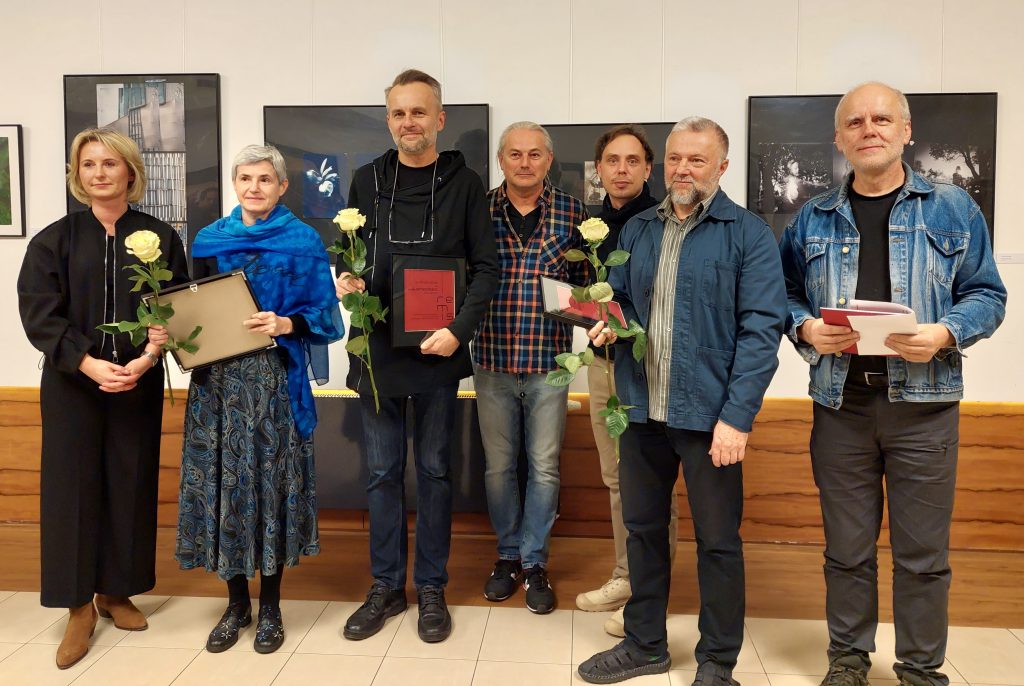In Ostrow Wlkp. REMIS, with AI lurking in the background

In the late afternoon of October 19, the opening of the works of the just-concluded XXIV edition of the Biennale of Photography in Analog Techniques and Digital Image Processing took place at the PIK Gallery of the Ostrów Cultural Center. The jury of the competition this time did not award the Grand Prix, but the four authors awarded with equal prizes showed not only a high level of photographic craftsmanship, but also an interesting artistic offer in the specialties they presented.
Since this was the last edition before the jubilee of the Ostrów Biennale of photography in techniques - generally speaking - analog, with an indication of special and noble techniques, and in digital image processing, let us remind you now what is hidden under the word REMIS, which is the name of this Biennale. Thus: R(elief), E(Sabattier's fekt, or pseudosolarization), M(ontage), I(zohelia), S(olarization). Thus, the Ostrovsky acronym is not just a neat jigsaw puzzle of letters, it is also a semantic reference to the original meaning of the word "tie" - the result of a game, sports competition, or other contest in which neither side is defeated; also an inconclusive game. Therefore, in a competition that has quite a tradition, the competition is between craftsmanship and computer, between darkroom and graphics program, between chemistry harnessed to artistic activities and the power of algorithms.


It should be remembered that in the case of the Ostrów Biennale, this real draw occurs when the Jury does not designate a contestant for the Grand Prix award. And this is an award for either analog techniques or digital processing. And that's exactly what happened this year, so four equal prizes were awarded - two for "handicraft" and two for "digital." Among them were: Izabela Maciusowicz from Warsaw (On the shoulder - Vandyke bronze), Adam Fleks of Gdansk (Wrecks. A study of decomposition - liht print), Jaroslaw Sankowski of Brzozow (APZ Corner - digital image processing) and Pawel Patynowski of Kalisz (Untitled 2 - digital image processing). This year's Jury meeting, once it became clear that none of the submitted works deserved the grand prize, was clearly animated, primarily because of several artifacts. Once it was about a beautiful work in which it was difficult to find the photographic source of the elements that make up the graphic montage, once it went about the superiority of pinholics over Vandyke bronzes (or vice versa), and a third time it was about whether photographic-painting abstraction must lose out to photographic-painting surrealism. There was also an issue: whether kitsch and obscene deserve the jury's attention. The most emotional question was posed by Jacek Boczar: What if we are already dealing with the creations of artificial intelligence here? The question is significant, because neither the Biennale's rules and regulations (so far) provided for such a form of work, nor did the jurors have the tools at hand to decipher such possible "photographic manipulation."
So let's remind ourselves that artificial intelligence is gaining popularity due to its capabilities and versatility. In the main, this is happening through powerful tools made freely available to all who are willing and able to use them. One of these is ChatGPT calling itself Assistant, and the other AI-based tool is Midjourney. Unlike ChatGPT, which is able to write a poem or a piece of prose for a person, Midjourney helps unlock new ideas and insights into specific things or will simply paint what it types in as a task for it, eventually creating an image that mimics a photograph. Even today, it's not just new media theorists who are convinced that our eponymous AI is becoming a threat to living authors, or it could prove indispensable for creating conceptual images of clothing or artwork, or even visualizing projects in the field of architecture.

Is there anything to be afraid of? For the time being, it's not about fear, but about readiness to face the problem that is already knocking at our door. As stated by the participants of the Ostrów vernissage, we have come to live in interesting times, because here and now, in the real world, revolutionary changes are taking place, phenomena are materializing that not so long ago belonged only to the sphere of film and literary science fiction.
*
Jury of the XXIV Biennale of Photography in Ostrów Wielkopolski: Mariusz Hertmann (chairman), Jacek Boczar, Andrzej Staszok, Maria Szeląg, Krzysztof Szymoniak. Author of the opening text of the catalog - K. Szymoniak. Curator of the exhibition - Andrzej Staszok. Design and composition of the catalog: Jagoda Kaszuba, Maria Szeląg. Arrangement of the exhibition - Jagoda Kaszuba. Authors of works qualified for the post-competition exhibition: Dominika Cybuch, Piotr Dras, Agnieszka Duszczak, Adam Fleks, Julia Golan, Łukasz Grycicha, Wojciech Domagała, Edward Jastrzębski, Paweł Klekowski, Agnieszka Kot, Sebastian Łuczak, Izabela Maciusowicz, Lidia Misztal, Paweł Patynowski, Sebastian Przybyła, Magdalena Samborska, Dorota Sankowska, Jarosław Sankowski, Paweł Tomczyk. Salon of the rejected - Michal Dzideczek, Andrzej Wiktor, Andrzej Ziemkowski.








Photo Report: K. Szymoniak
